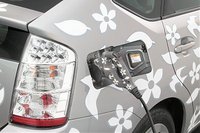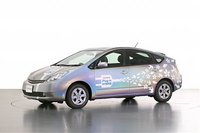Toyota Delivers Plug-in Prius to UC Irvine and UC Berkeley as Part of Clean Mobility Partnership
TORRANCE, Calif., Nov. 9, 2007 -- Toyota Motor Sales, U.S.A., Inc., (TMS) today presented two Toyota plug-in (PHEV) hybrid prototypes to the Institute of Transportation Studies at the University of California, Berkeley (UCB) and the Advanced Power and Energy Program at the University of California, Irvine (UCI) as part of its on-going sustainable mobility development program with the two UC campuses.
"We feel there is tremendous promise in plug-in hybrids," said Bob Carter, Toyota Division group vice president and general manager. "However, there are still many questions to be answered and challenges to be resolved before Toyota can bring a product to market that has the quality, durability and reliability that customers expect from us. The universities will help us and California better understand what it will take to turn these options into meaningful solutions."
Toyota has a long history of working collaboratively with both universities on the development of advanced technology and alternative-fuel vehicles, including demonstration and research programs involving fuel cell vehicles, gas-electric hybrids and pure electric vehicles. This next phase of the partnership involving plug-in hybrid vehicles is being funded jointly with the California Air Resources Board (CARB) and the California Energy Commission (CEC). The goal of this program, which was authorized under California Assembly Bill 1811, is to incentivize the use and production of alternative fuels and vehicles.
"As the state with the nation's most challenging air quality issues, California has a vital interest in developing and promoting the use of clean, cutting-edge automotive technologies," said Thomas Cackette, chief deputy executive officer of CARB. "The Air Resources Board is proud to play a pivotal role in financially supporting this plug-in hybrid project. We look forward to the results of the study and the potential implications this groundbreaking research may have for all of us in California who want cleaner transportation options."
The Toyota PHEVs delivered today are based on the current-generation Prius, the world's first and most popular hybrid vehicle. The cars are powered by oversized packs of nickel-metal hydride batteries that effectively simulate the level of performance Toyota expects to achieve when it eventually develops more advanced, compact and powerful battery systems.
The prototypes are designed to run in electric mode more often, and at higher speeds, than the current Prius. This results in substantial gains in fuel economy and a major reduction in total tailpipe emissions. Reductions in CO2 emissions will vary depending on the source of the electricity that recharges the secondary battery. Charging is done conveniently, with an ordinary three-prong cord and household electrical outlet. The extra battery is housed in the trunk, taking up what was space for a spare tire.
UC Irvine will be focusing on some of the technical challenges, as well as determining the emissions benefits of plug-ins, including:
-- How to measure and test fuel economy and vehicle emissions;
-- How to account for the upstream emissions from electricity generation;
-- In regions with a higher-carbon grid mix, whether plug-ins would
provide an emissions benefit.
"The Toyota PHEV represents the introduction of electricity into a fuel mix that supports a full-featured vehicle," said Scott Samuelsen, professor and director of UC Irvine's Advanced Power and Energy Program. "Our alliance with UC Berkeley will allow us to undertake key research in areas ranging from engineering to social dynamics across the breadth of California."
UC Berkeley will primarily focus on the customer experience, including:
-- Whether consumers would want to plug in their vehicles;
-- What trade-offs drivers are willing to make between range, charging
time, battery size and battery cost;
-- When people will charge and if drivers will want access to outlets
where they work and shop.
"The Institute of Transportation Studies at UC Berkeley is delighted to participate in the Clean Mobility Partnership with the project's sponsors and partners," said Prof. Mike Cassidy, acting director of the institute. "The project will conduct ground breaking, real-world research with plug-in hybrid and fuel cell electric vehicles to better understand potential vehicle usage and refueling patterns, consumer perceptions, economics, and energy and environmental impacts."
All of these questions are important in determining the optimal product attributes. Developing a future vehicle landscape that includes alternative fuels and high-efficiency, low-emission vehicles will require the coordination and cooperation of many partners. Toyota will continue to do its part to advance all of the possible solutions to reducing the greenhouse gas and emissions impacts of the automobile.
Specifications
Model Name Toyota Prius
Plug-in HV
Length/Width/ 4,445/1,725/
Height 1,490mm <--
Weight 1,360kg 1,260kg/2,832 lbs.
Passengers 5 persons <--
E V
performance EV driving range Approximately Brief periods,
7 miles, occasionally up
full charge to a few minutes
(US LA #4 mode), at very low
driving speed speeds.
and style No EV-only mode.
dependent
EV mode About 62 About 20 mph under
Maximum speed a very light
throttle
Engine Capacity 1,496cc <--
Maximum Power 56kW(76PS)/ <--
5,000rpm
Maximum Torque 110N-m <--
(11.2kg-m)/
4000rpm
Motor Type Alternating <--
current dynamo
Maximum Power 50kW(68PS)/ <--
1,200~1,540rpm
Maximum Torque 400N-m <--
(40.8kg-m)/
0~1200rpm
Secondary Type Nickel-metal <--
Battery hydride
Capacity 6.5Ah x 2 (13Ah) 6.5Ah
Regular Voltage 202V <--
System Maximum Power 100kW(136PS) 81kW(110hp)
System Voltage 202~500V <--
Battery
Charge Power supply Household <--
electrical
energy
Charging time 1~1.5 hours <--
(200V)
3~4 hours
(100V)




